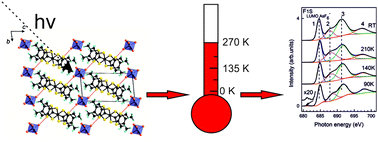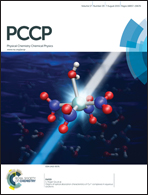Donor–anion interactions at the charge localization and charge ordering transitions of (TMTTF)2AsF6 probed by NEXAFS
Abstract
High-resolution near-edge X-ray absorption fine structure (NEXAFS) measurements at the As M-edge, F K-edge and S L-edge of the Fabre salt (TMTTF)2AsF6 were performed from room temperature (RT) to 90 K, allowing to reach the charge localization regime below Tρ ≈ 230 K and to cross the charge ordering (CO) transition at TCO ≈ 102 K. The F K-edge and S L-edge spectra exhibit several transitions which have been indexed on the basis of first-principles DFT calculations. Upon cooling from RT significant energy shifts up to +0.8 eV and −0.4 eV were observed in transitions exhibited by the F 1s and S 2p spectra respectively, while the As 3p doublet does not show a significant shift. Opposite energy shifts found in the F 1s and S 2p spectra reflect substantial thermal changes in the electronic environment of F atoms of the anion and S atoms of TMTTF. The changes found around the charge localization crossover suggest an increase of the participation of the S d orbitals in the empty states of TMTTF as well as an increase of the strength of donor⋯anion interactions. A new F 1s pre-edge signal detected upon entry into the CO phase is a clear fingerprint of the symmetry breaking occurring at TCO. We propose that this new transition is caused by a substantial mixing between the HOMO of the AsF6− anion and the unoccupied part of the TMTTF HOMO conduction band. Analysis of the whole spectra also suggests that the loss of the inversion symmetry associated with the CO is due to an anion displacement increasing the strength of S⋯F interactions. Our data show unambiguously that anions are not, as previously assumed, innocent spectators during the electronic modifications experienced by the Fabre salts upon cooling. In particular the interpretation of the spectra pointing out a thermally dependent mixing of anion wave functions with those of the TMTTF chains demonstrates for the first time the importance of anion–donor interactions.


 Please wait while we load your content...
Please wait while we load your content...